Pipe Bending Machine Ultimate FAQ Guide
Source:Liye Machinery(LYM) Co.,Ltd Release time:2021-12-02 13:13:07 Visit:1076


Contents
Chapter 1. What is a pipe bending machine?
Chapter 2. What is the working principle of a pipe bending machine?
Chapter 3. How many types of tube bending methods are there?
Chapter 4. How many types of bending are involved in a cold bending technique?
Chapter 5. What is the difference between press bending and rotary draw bending?
Chapter 6. What tools are used for tube bending machines?
Chapter 7. Why is a mandrel used in the pipe bending process?
Chapter 8. What materials are used to make a pipe bending machine tools?
Chapter 9. What metals tube bending machines can bend?
Chapter 10. What is pipe bend radius?
Chapter 11. How to choose a suitable tube bending machine?
Chapter 12.What are the reasons for tube wrinkling even while using a mandrel bender?
Chapter 13. How to prevent wrinkles and creases while using a pipe-bending machine?
Chapter 14. What is the difference between an NC pipe bending machine and a CNC pipe bending machine?
Chapter 15. What are the benefits of a tube bending machine?
Chapter 16. What are the applications of pipe bending machines?
Chapter 17. Does the pipe bending machine need lubrication?
Chapter 18. How much lubricant is required for a tube bending machine?
Conclusion
Tube or pipe bending machines are designed to fabricate tubes and pipes to change their shape. These machines can easily make precise bends and curves at specified points of pipe segments. These bent tubes are hollow and can be used in various applications i.e. pneumatics, hydraulics, aeronautics, medicinal, and many other process applications.
LYM(Liye Machinery) have devised this FAQ guide to help you learn more regarding pipe bending machines, techniques, and the best way to choose one for you.
Chapter 1. What is A Pipe Bending Machine?
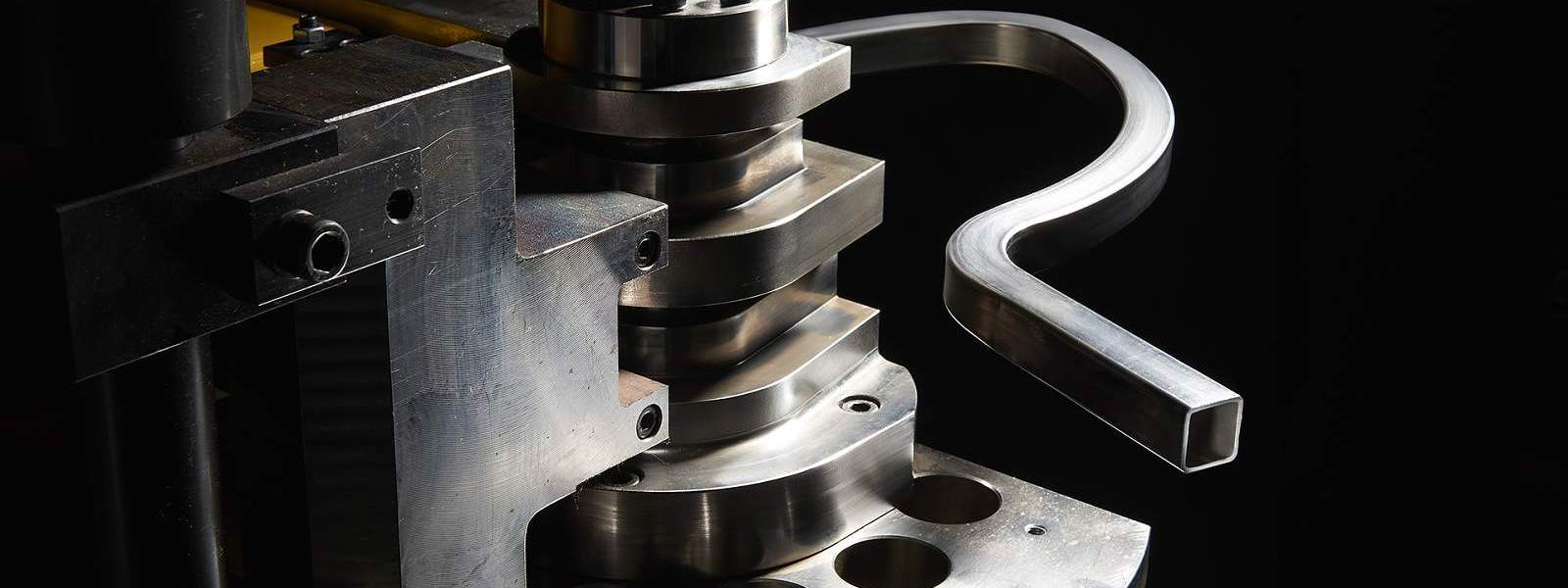
The tube bending machines come in different forms; they can be manually operated or automatically supported by hydraulics or electric motor.
Manual pipe benders don’t require any electrical energy contribution. That’s why they mostly are quite inexpensive and easily accessible. Such machines are operated through mechanical controls that are capable of enhancing exerted force, to produce efficient tube bending action.
Alternatively, automatic pipe bending machines can execute single or multiple bends at the same time. Moreover, by continuous technical expansions, these machines can be upgraded to speed up tube fabrication operations. Automatic tube bending machines are designed to offer repeated flawless production.
Chapter 2. What Is The Working Principle Of A Pipe Bending Machine?
The type of pipe bending machine you require is determined by the pipe bending process and materials.
The pipe is mounted onto the pipe bending machine. The pipe is tightly fixed between clamping and bending dies to prevent slipping. The tube is also held by the wiper and the pressure die for additional support. A wiper die is made of soft alloy i.e. aluminum to evade damages such as scratches and collapses.
Mechanical force is applied on the pipe or tubing to move forward alongside the dies.
The shapes of the dies are used to determine the configuration of the pipe and curve radius as well. The force applied to the pipe over the dies forces it to follow the die conformation. For some processes, a mandrel is placed in the pipe interior to prevent the formation of wrinkles and creases during the bending process.
Chapter 3. How Many Types Of Tube Bending Methods Are There?
Before you start bending pipes, there are some important aspects to think of first. These factors determine the efficiency and precision of your operations. There are various tube bending machines functioning on distinctive techniques.
The most important factor to consider is the purpose of tube bending and the form of pipe material.
However there are several approaches and machines for efficient pipe bending, they can be categorized into two classes:
• Cold bending method
As the name suggests such a bending technique involves certainly no consumption of heat for the pipes to bend. The cold bending technique completely depends upon mechanical force. As there is no heat involved physical force is applied to the pipes to shape them in a different configuration.
The tube bending machines working on this principle covers the pipe or tube around the die. The die or any other shape is used that can effectively bend the pipe by force.
• Hot bending method
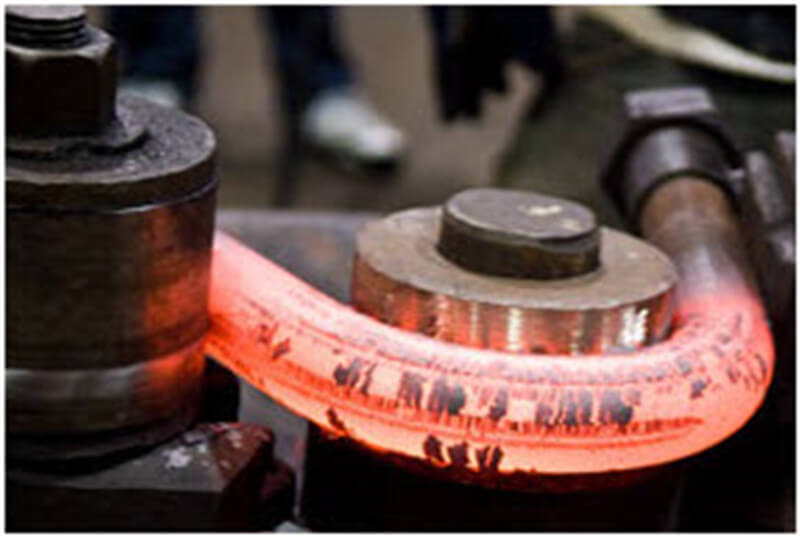
The hot bending technique includes heating the pipe at a certain temperature to make precise and swift bends. Hot bending can also be referred to as induction bending.
Normally, the portion of the pipe that has to be bent is subjected to heat. The heat makes it softer, and it can be bent without putting in much energy.
The type of bending method you chose determines the final shape of the tube or pipe.
Chapter 4. How Many Types Of Bending Are Involved In A Cold Bending Technique?
By using the cold bending method you can bend any pipe or tubing without using any heat. Only sheer force is exerted on the pipe to create bends. The cold bending machines are designed with no heat principle, but they require more energy.
Here is a brief description of some further categorize of cold bending techniques:
• Rotary Draw Bending
A rotary draw bending machine uses an arrangement of tooling including dies and many other constituents. The components are fixed to have continuous rotary movement. The rotating dies to force the pipes to keep moving ahead and create the desired results.
• Mandrel Bending
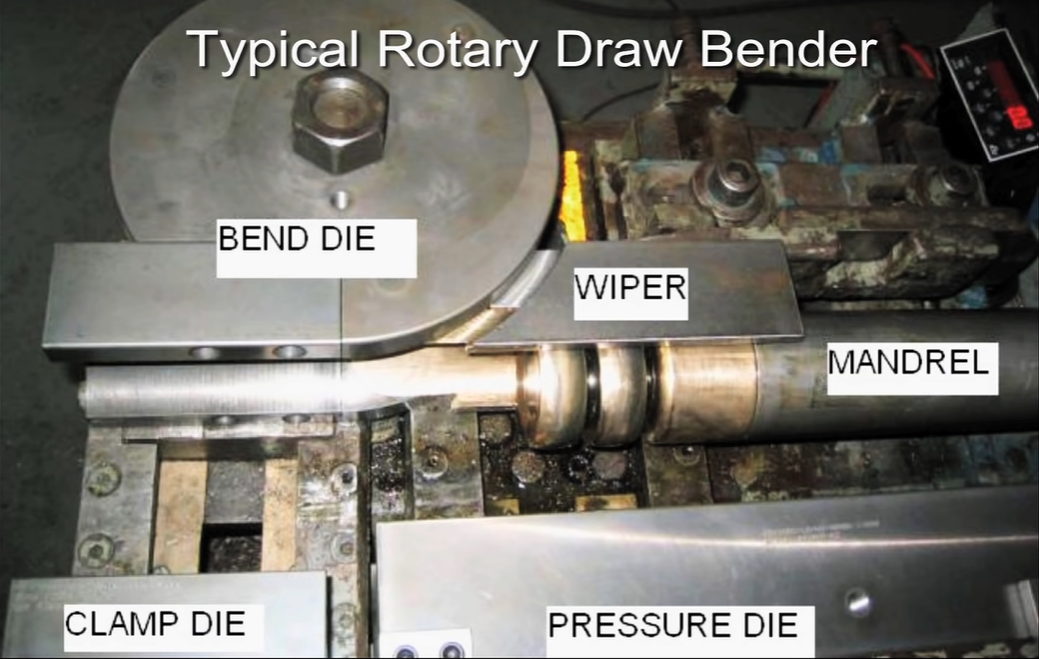
• Compression Bending
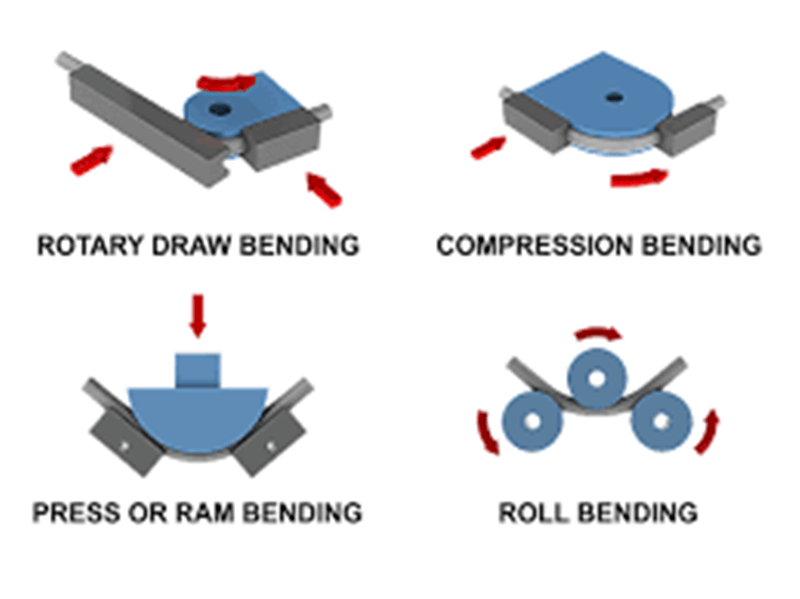
The stationary dies have the desired shape to which the pipe has to be bent. The counter die wraps the pipe around the stationary die to create the final shape.
• Roll Bending
The roll bending technique is mostly preferred for large radius bends. The roll bending method principle includes passing the tube or the pipe through many rollers. A roll bending machine has a sequence of rollers arranged in a pyramid-like structure.
These rollers are important for making the desired shape for your pipe or tube
Chapter 5. What Is The Difference Between Press Bending And Rotary Draw Bending?
Press bending machines contain a special bend die. The die is designed to create a curve in the pipe or a tube. The pipe is fixed and pressed towards the bend die to create the desired shape. The technique is most straightforward and convenient.
While a rotary draw bending contains a complete set of dies. The pipe is moved through many dies to create a perfect bend form. The rotary draw bending machine rotates the tubes to exert pressure resulting in a precisely curved surface. Such tubes are used in various industries and applications.
The press bending results are not much precise and accurate as compared to the rotary draw bending technique. The press bending machine is not compatible with internal support i.e. mandrels for the pipes.
While rotary draw bending machines allow you to add additional support to the pipes for better results.
Chapter 6. What Tools Are Used For Tube Bending Machines?
Tube bender dies are the most important tools used for efficient bending. High-end bender dies are essentially used to back up and accelerate the bending operation. All the dies used have distinctive functions, each of these plays a vital role in the process.
Here is a brief explanation for the bender die tools that are used in many tube bending machines:
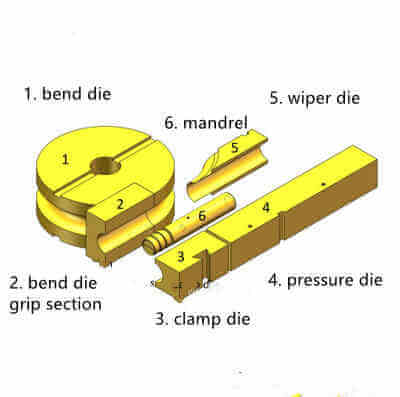
Bend Die
Such dies are most commonly used as an essential part of rotary draw tube bending machines. These dies are also referred to as radius dies or bend formers. They are used to apply force on the pipe to make precise bends.
The pipe can be easily fixed in the die, it is moved forward, and curves are created at desired points.
Clamp Die
Such dies are used to keep the pipe in position during the bending operation. To prevent bending errors i.e. collapse, it is best to fix your pipe in position and avoid slipping.
Pressure Die
A pressure die is attached to a tube bending machine to make certain the pipe moves forward towards the bend die without any hindrance.
Wiper Die
Soft alloys i.e. aluminum and brass are used for the creation of wiper dies. Such materials are capable of avoiding scratches and damages to your pipe. Mostly, the damages are caused by friction between the pipe and the dies.
A soft alloy-based dies can reduce the chances of damages during tube bending operation. It allows you to produce a smooth even surface on the outside as well as inside of the pipe surface.
In the automatic tube bending process, the wiper bend starts operating just after the bend dies. By doing so, you can easily smoothen the inner and outer surfaces of the pipe.
Mandrel
While working with a small radius pipe, a mandrel is a must-have item to help to prevent these problems i.e. collapsing. They can be installed inside a pipe and act as additional protection.
Chapter 7. Why Is A Mandrel Used In The Pipe Bending Process?
The mandrel is mostly referred to as a pipe bending supporting tool more than a technique itself. Due to the exertion of pressure on the tube, in a normal bending process, it inevitably thin out. It can result in the occurrence of bending defects and errors i.e. tube collapse, tight curve radius, and flat bends.
To tackle and reduce the chances of such bending problems, a mandrel can be used. You can place the mandrel inside the pipe at the bend point. The mandrel provides extra support and protection to the pipe. You can get more pr&#a233;cised and effective results.
A rotary tube bending machine is capable of forming a firm and tight bending radius. Such pipes can collapse and flatten pretty quickly. Adding a mandrel to the pipes before the pipe bending process will offer support and assistance to the pipe core. It will prevent damages and errors that may occur during the pipe bending process.
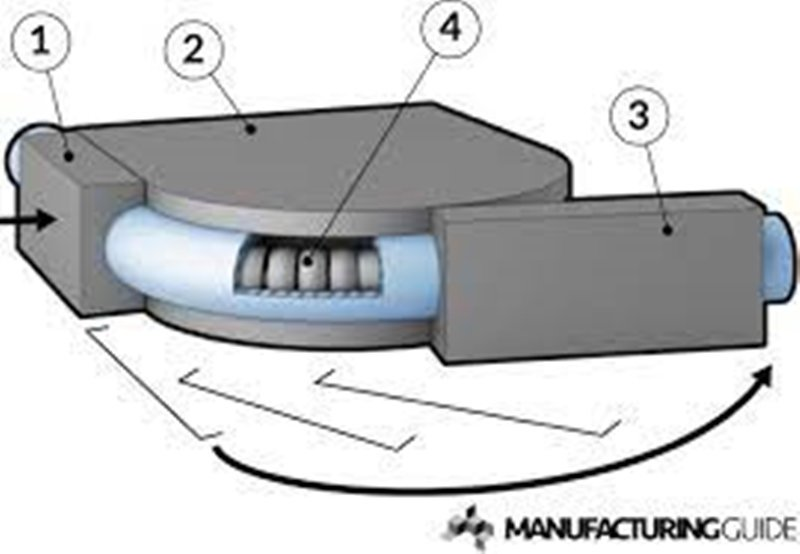
Chapter 8. What Materials Are Used To Make A Pipe Bending Machine Tools?
The tooling used for a pipe bending machine is manufactured by using the most durable and sturdy material. The efficiency and functionality of these tools determine the overall performance of a pipe bending machine.
The nature of the tools used in a pipe bending machine depends upon the bending technique and desired shape.
The tools used in pipe bending machines are mostly made of:
• Tough steel
Such tools are made of some of the most high-quality and sturdy steel. The hard steel tools are long-lasting and reliable. The hard steel tools can easily bend hard tubes and pipes.
Steel-based tools and dies are highly effective while working with carbon steel, stainless steel.
• Soft alloys
Some of the tools are required to be soft and flexible, that’s why are made using softer material i.e. aluminum. The softer alloys are used in the case of small and weak pipes to apply lesser force and make precise bends.
Aluminum tools and dies are preferred while, bending aluminum, copper tubing.
Chapter 9. What Metals Tube Bending Machines Can Bend?
Tube bending machines have specific compatibility with pipe material. A high-end tube bending machine can work with various metals at the same time.
The material of a pipe determines the pipe bending technique you should use.
Here is a list of important metals widely working with tube bending machines in many industries
- Aluminum
- Brass
- Carbon steel
- Stainless steel
- Copper
- Nickel alloys
- Titanium
- Superalloys
Chapter 10. What Is Pipe Bend Radius?
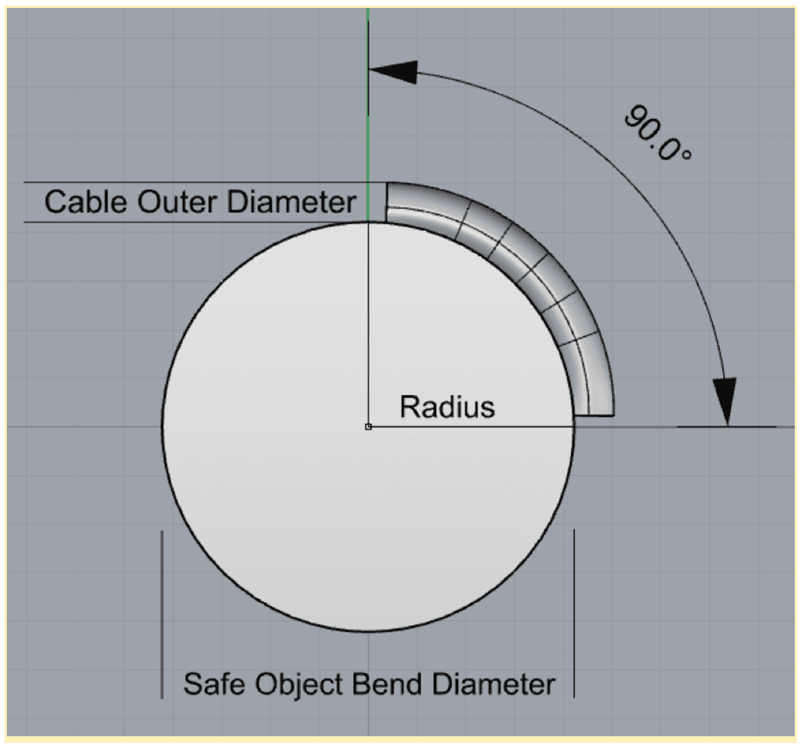
The midpoint bending radius of a pipe is termed to be as its bend radius. The bend radius of a pipe depends upon the shape of the curve you want. It is important to consider the bend radius for a pipe before the bending process.
The different bending radius of a pipe offers distinctive attributes. If the pipe has a larger bending radius, it will have a rather smooth surface.
The bending radius of the pipe should be determined according to the pipe diameter. If the diameter of the pipe is larger as compared to the bending radius, there are fewer chances of bend errors i.e. wrinkles and creases.
That’s why you should always go for a 2-3 times larger bending radius, in contrast to the pipe diameter you are trying to bend. It is also important to maintain a constant bending radius for a pipe.
Chapter 11. How To Choose A Suitable Tube Bending Machine?
It is important to invest your money in a tube bending machine that highly resembles your requirements. For this reason, you should consider some factors before choosing a bending machine for you. Here are some points to think of regarding a pipe bending machine:
- Design
The first thing to consider is the design of the pipe bending machine. Start by determining the design that is highly compatible with you. You should always opt for a design that is easy to use and offer the most effective bends.
Some pipe bending machines are designed poorly and may cause the pipe to slip during the operation. It will lead to bending errors i.e. collapses and wrinkles.
- Capacity
It is also important to determine the capacity of the pipe bending machine. Some machines are quite selective against the pipe diameter. Always select a machine that is compatible with many different pipe diameters.
Make sure to also consider the bending process, wall thickness, and bend radius of the pipe as well
- Quality and bending accuracy
You should also consider the quality of a tube bending machine. A high-end, high-quality tube bending machine is durable and can withstand the test of time. You should also think of the accuracy of the bends it can create.
Some machines are not quite efficient, thus causing many bending errors. However, a high-quality bender allows you to make precise curves for every operation.
- Tool durability
The effectiveness of a pipe bending operation depends upon the quality of tools used in the machine. Consider a pipe bending machine that uses high-quality and durable material for its tooling.
You can assure the quality of each bending operation by going for high-end tools as they are designed to offer precise bends devoid of any defects.
Chapter 12.What Are The Reasons For Tube Wrinkling Even While Using A Mandrel Bender?
Sometimes even while using a mandrel bender, the bending process isn’t much effective. The mandrel is used to prevent bending error, but still, there are chances of pipe wrinkle and collapse.
Here are some reasons for a tube to wrinkle even after using a mandrel bender:
- Slipping of the tube through the clamp dies
- The mandrel may not be placed properly
- The wiper die may not be adjusted properly on the bend die
- The wiper die may be damaged and may not fit well
- Lesser pressure presented on the pressure die
- Wiper die worn or of improper fit
- Inadequate lubrication
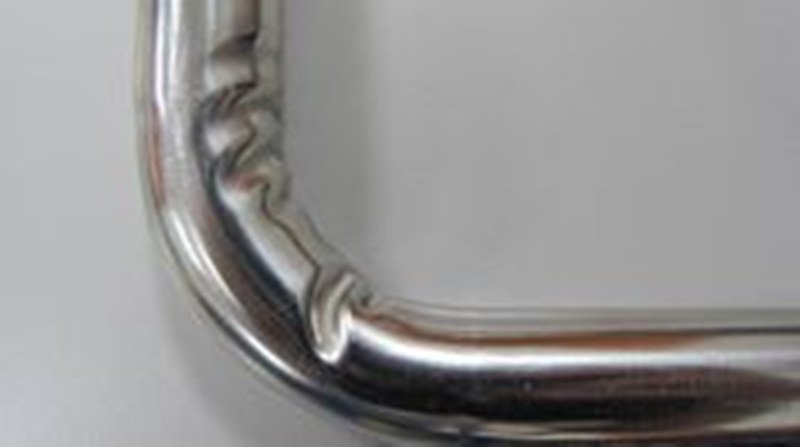
Chapter 13. How to prevent wrinkles and creases while using a pipe-bending machine?
Wrinkles and creases are the most common bending errors.
Here are some ways to prevent bending errors while using a pipe bending machine:
- The bender should be of the right dimensions; if the bender is smaller than the tube radius it would be tough on the pipe, creating an uneven wrinkled surface.
- The quality of bends created by a pipe-bending machine also depends upon the type of tubes you use. Use bending machines with suitable tooling for the tube material.
- Use a pipe bending machine that can strongly hold the pipe in place. It can prevent wrinkles and offer quality bends.
- A mandrel can lower the chances of bending errors including wrinkles and creases. It can firmly fix the pipe in position and prevent slipping.
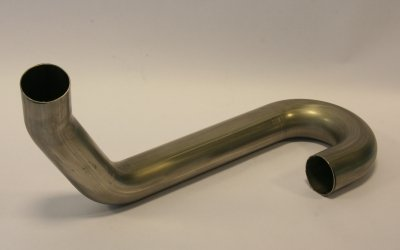
Chapter 14. What Is The Difference Between An NC Pipe Bending Machine And A CNC Pipe Bending Machine?
NC and CNC pipe benders are both automatically operated machines. Both of the machines can be controlled by using a computer program, you can command the machine to perform certain desired functions.
An NC or a numerical control pipe bending machine is a semi-automatic pipe bender. Its simple operation, high bending accuracy, and low price make it an economical and practical choice for small and medium-sized production environments.
Alternatively, a CNC or a Computer Numerical Control pipe bender is a completely automatic machine. It is equipped with a CNC control unit with a touch screen interface, all parameters are editable. The CNC pipe bender has very high precision, can perform complex 3D bending and can meet various manufacturing needs.
A proficient and experienced staff is required to operate a CNC pipe bending machine.
Chapter 15. What Are The Benefits Of A Tube Bending Machine?
Pipe bending machines are being used in different industries because of their numerous advantages. By using tube bending machines you can enjoy the following perks:
- A tube bending machine can perform multiple operations at the same time.
- It lowers the production costs.
- Tube bending machines offer the most precise and effective bends.
- Pipes bent by using high-end tube bending machines have a smoother finish.
- Effective bends without any damages are created without any risks of tube damages and leaks.
- With a tube bending machine, you can accelerate your bending operation.
- A tube bending machine with its automated functions can save you from any physical effort.
Chapter 16. What Are The Applications Of Pipe Bending Machines?
Pipe bending machines are being used in a wide range of industries. They are being used for different purposes and in many instruments as well. The most common and popular use of bending machines is in automotive industries, as their operation requires many bent tubes and pipes.
Apart from automotive, modern pipe bending machines are also quite eminent in many other fields. Some of these are as follows:
- Play area equipment
- Fitness machinery
- Refrigeration pipes, tubes, and other metal constituents
- Shipping gear
- Agricultural tools
- Tanks and steel vessel boosters
- Industrial manufacture
- Architectural operations
- Furniture modules
- Automotive industry and vehicles
- Ship Construction
- Aeronautics and aerospace
Chapter 17. Does The Pipe Bending Machine Need Lubrication?
Lubrication is an important practice for any tube bending process. Tube bending machines require regular lubrication for effective and long-lasting performance. You must carefully apply a lubricant on all the tools and accessories of a pipe bending machine.
In a tube bending operation, the tools are meant to move back and forth against each other. Without proper lubrication, the rubbing will create friction and damage the machine. For a smooth process, you should regularly apply a considerate amount of lubricant on machine parts including wiper die, outside diameters, and inner radius of the tube.
Different lubricants are used for a wide variety of materials like steel,aluminum,copper,titanium.
Chapter 18. How Much Lubricant Is Required For A Tube Bending Machine?
Lubrication doesn’t only offer a smooth operation, but also additional protection for your machine. Recently, a common conception is that using an abundant quantity of thick lubricant over the machine components creates an invincible barrier.This might be true in some conditions, but in most cases using a large amount of a dense lubricant is needless and can cause much more damage. Using a trivial amount of a premium quality lubricant is considered much more effective.
It can accelerate the bending process and is also easier to clean afterward.
Conclusion
Pipe bending machines are designed to be highly straightforward and precise. Using a tube bending machine is a much swifter and more effective way to bend pipes, even for smaller (as well as larger) industries. This FAQ guide contains all the information needed to pick an ideal pipe bending machine for you.
LYM(Liye Machinery) hope our guide will help you learn and make better choices.


